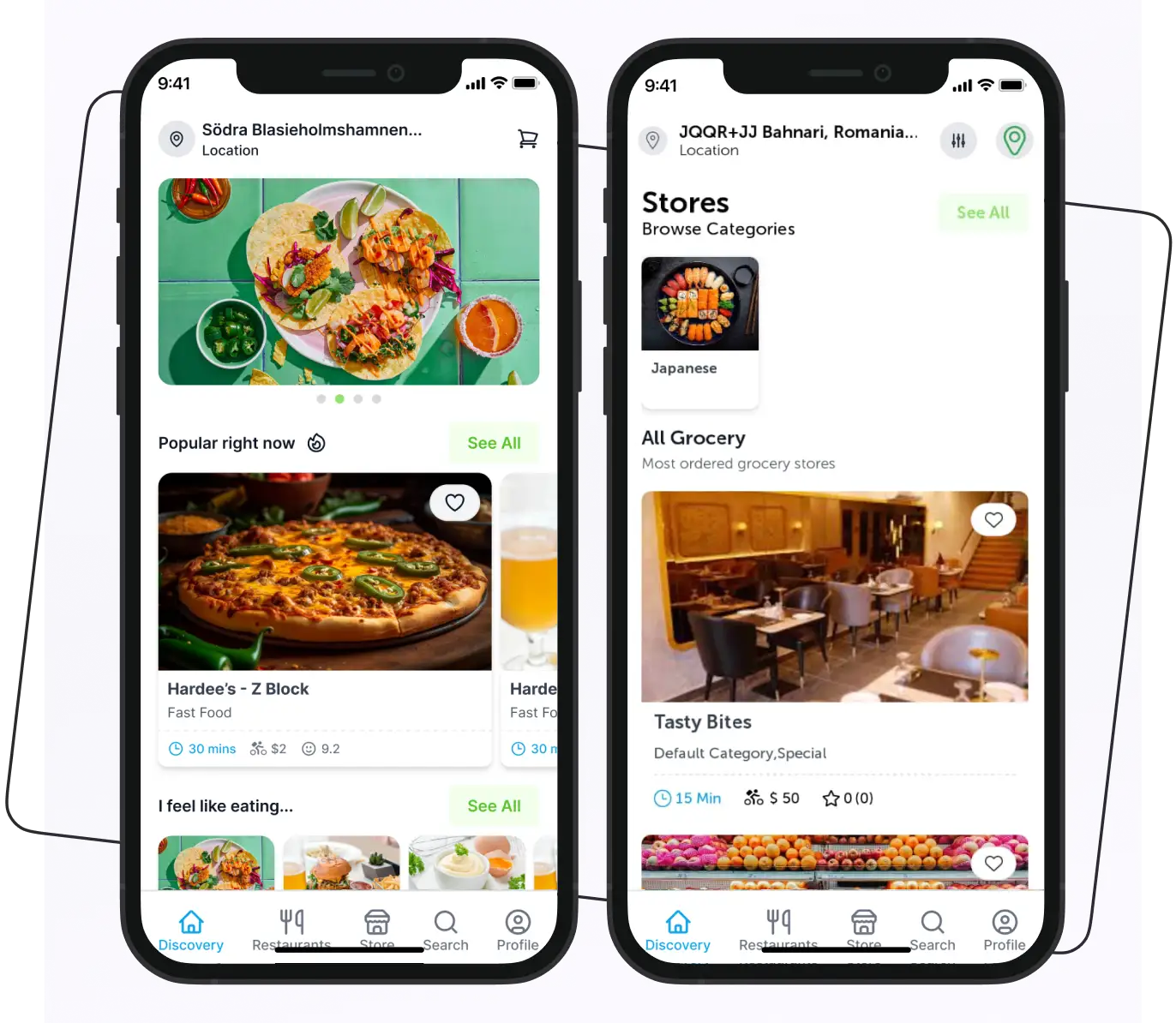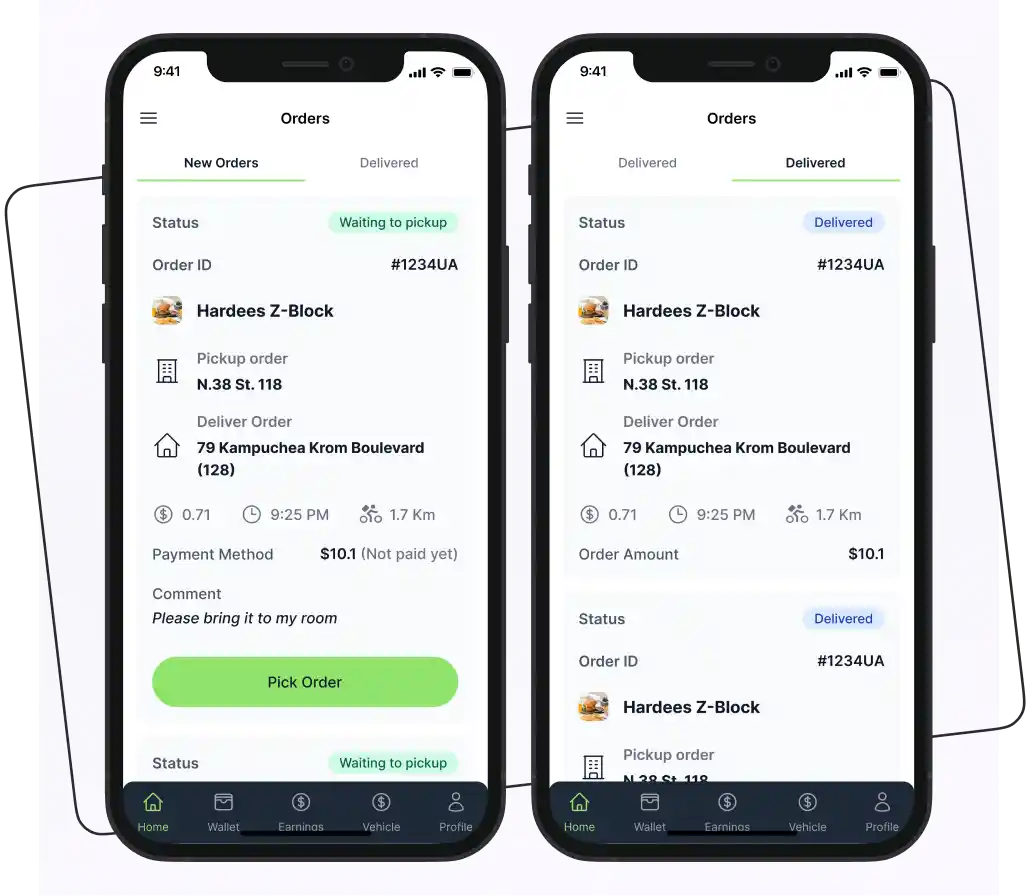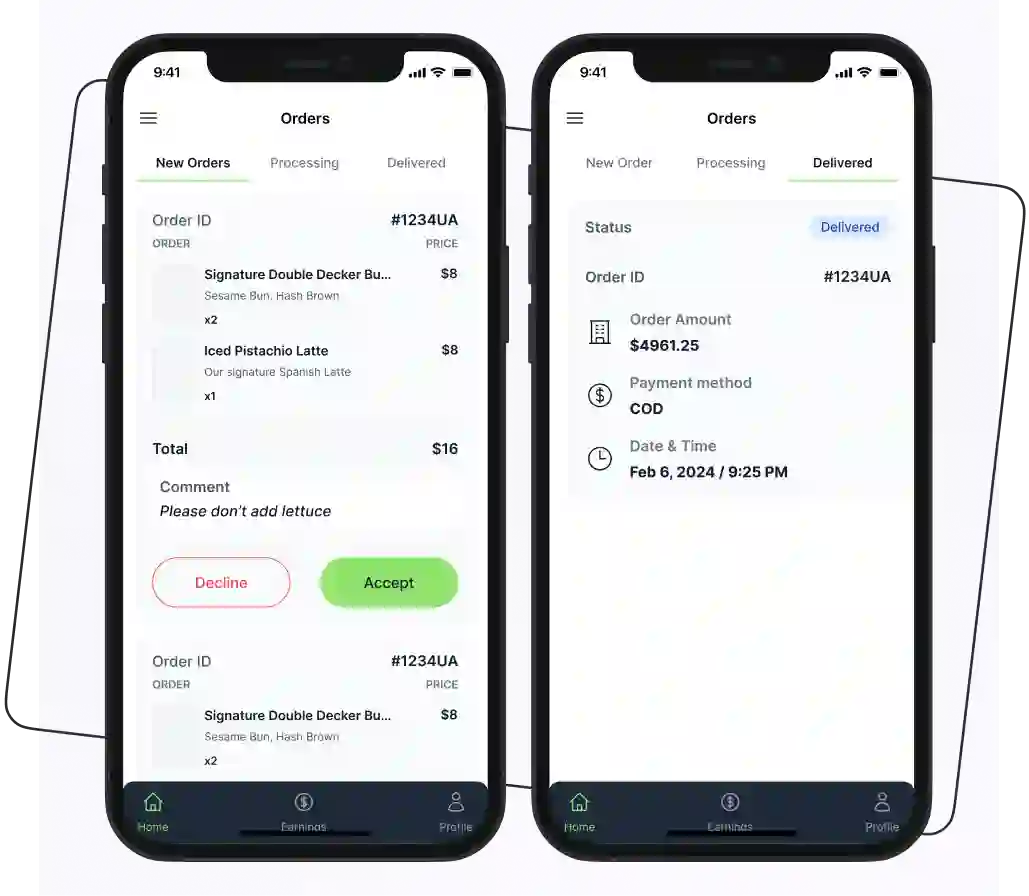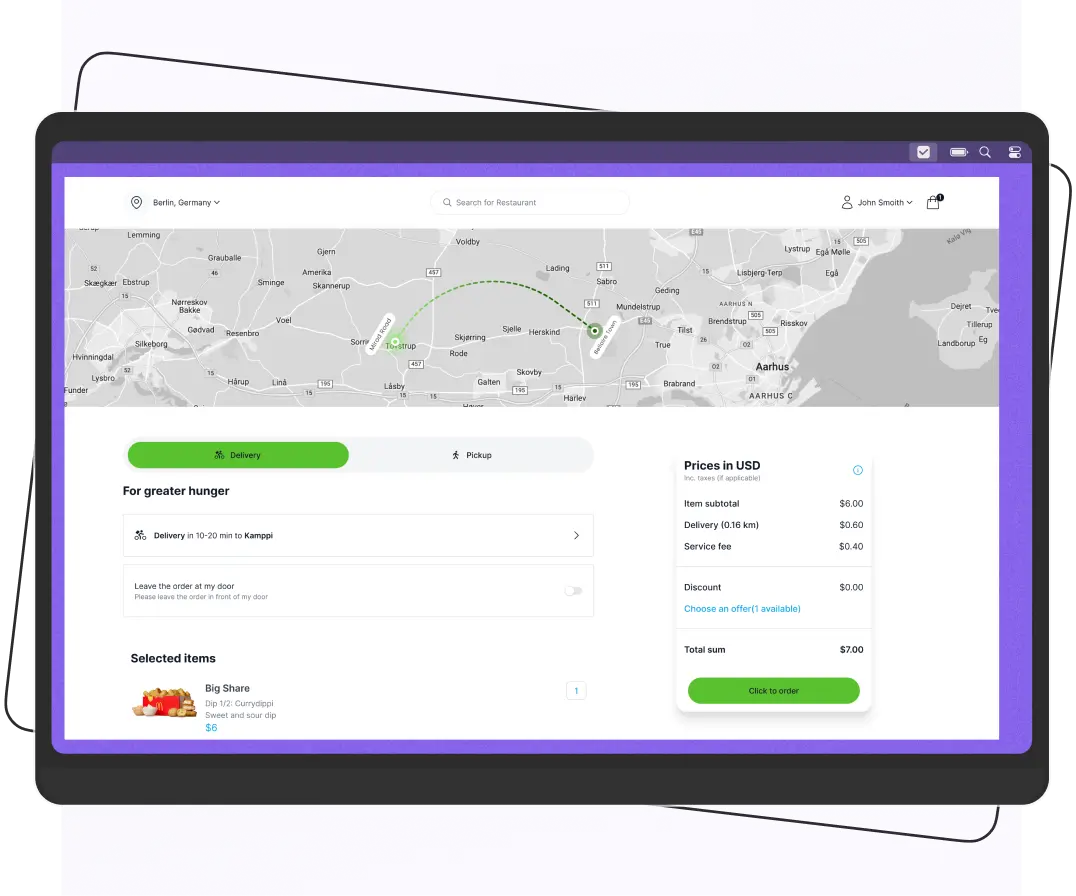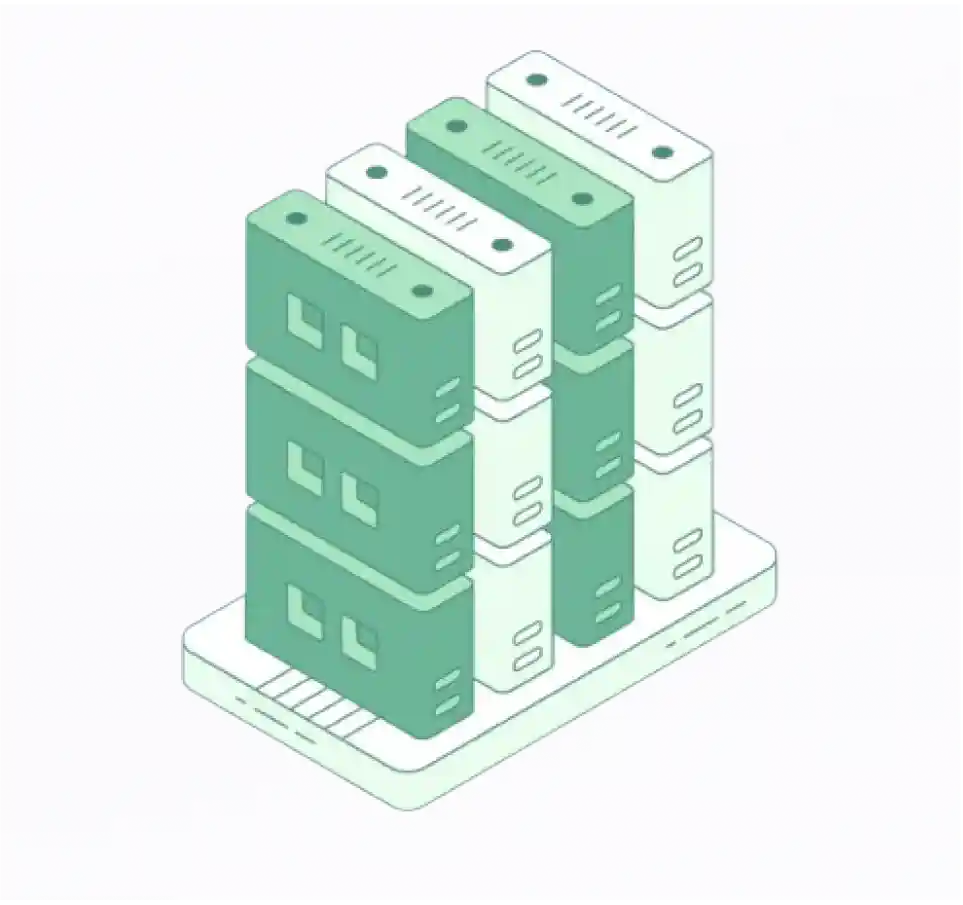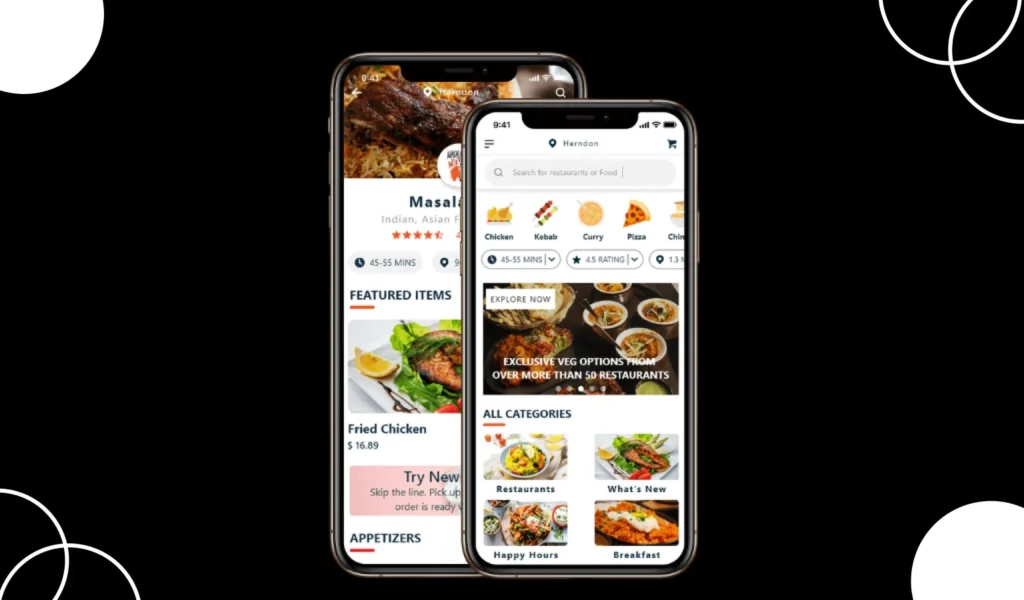
To stay competitive in 2025, investing in food delivery apps is essential. A well-designed app can increase user engagement and sales for your business.
However, many business owners face a common dilemma: should they develop a custom food delivery app tailored to their specific needs, or go for a ready-made solution that may be quicker and more cost-effective?
To help you decide, we’ve put together useful information to assist you choose the right one.
Supercharge your deliveries with Enatega.
Get Started NowWhat is a White-Label Food Delivery App?
A white-label food delivery app, or pre-built app, is a mobile application that a food business can customize according to its needs. They can change the logo, colors, and various features to align with their brand identity.
The main purpose of using a white-label food delivery app is to:
- Brand Customization: Businesses can personalize the app’s appearance and functionality to reflect their unique brand.
- Cost Efficiency: It allows a business to have its own branded app without the high costs and time associated with developing one from scratch.
- Quick Deployment: Businesses can launch their food delivery service quickly, taking advantage of an existing platform rather than starting from zero.
- Focus on Core Business: By using a white-label solution, businesses can concentrate on their core operations, like food quality and customer service, rather than technical development.
- Scalability: Many white-label apps come with features that can easily scale with the growth of the business. It helps to accommodate more users and orders without significant changes.
- Access to Advanced Features: These apps often include built-in functionalities such as real-time tracking, payment processing, and customer support, making it easier to manage operations.
Key Features of White-Label Food Delivery App
Look at the below and know the main features that you found in the white-label food delivery app.
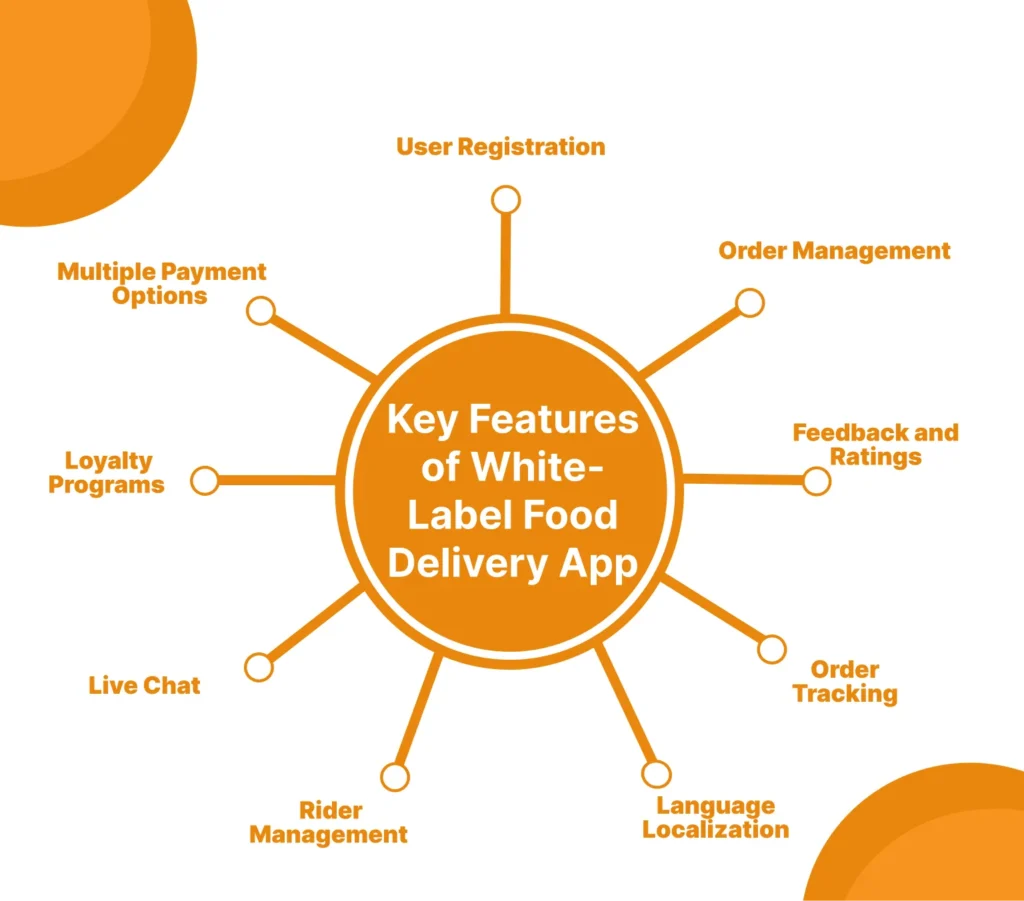
| Features | Description |
| User Registration | Users can easily create an account using their email addresses, phone numbers, or social media profiles. |
| Order Management | The white-label food delivery app helps you effectively handle incoming orders by keeping track of each order status and communicating with the customers for a better order process. |
| Multiple Payment Options | With integrations to various payment gateways, users can choose from digital wallets, credit/debit cards, or cash on delivery to pay for their orders. |
| Feedback and Ratings | User feedback and ratings are essential for both customers and businesses. Customers rely on reviews to assess the quality and reliability of restaurants and delivery services, while businesses use this information to understand customer satisfaction and identify improvement areas. This mechanism, commonly seen in platforms like Zomato, Uber Eats, and Swiggy, helps shape the online food ordering market. |
| Order Tracking | This feature allows both users and restaurants to monitor order progress. Users can view their order status from preparation to delivery, while restaurants can manage orders, track delivery drivers, and optimize routes. Popular apps such as DoorDash, Grubhub, Uber Eats, and Zomato all offer this feature. |
| Loyalty Programs | The app can implement loyalty programs to reward users for their orders and offer discounts for frequent customers. |
| Live Chat | Integrating live chat allows users to communicate directly with customer support, delivery personnel, or restaurant staff for assistance with their orders. |
| Rider Management | A rider management system within the app helps riders efficiently manage their tasks, track earnings, and maintain communication with customers and the platform. |
| Language Localization | The app provides a language localization feature to ensure users can navigate and use the app in their preferred language. |
Examples of Businesses Using White-Label Food Delivery Solutions
Here are some examples of businesses using white-label food delivery solutions.
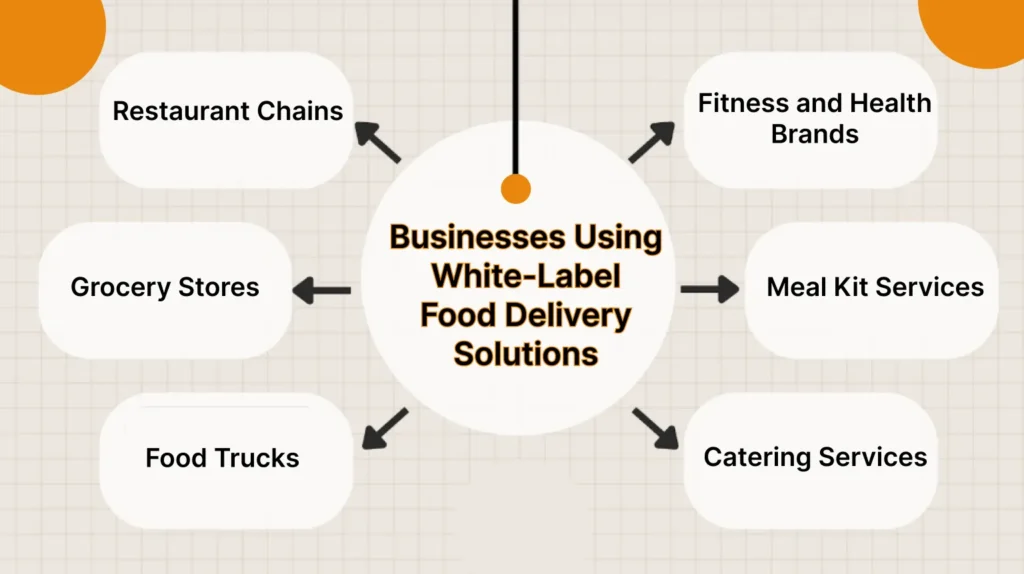
Restaurant Chains
Many large restaurant chains use white-label solutions to manage their delivery services without investing in their technology.
Grocery Stores
Some grocery chains implement white-label food delivery platforms to offer customers home delivery of groceries, competing with services like Instacart.
Food Trucks
Food trucks may use white-label delivery solutions to expand their reach.
Catering Services
Catering companies manage their delivery processes and large orders efficiently.
Meal Kit Services
Companies that provide meal kits may use it for delivery logistics, allowing them to focus on food preparation and marketing.
Fitness and Health Brands
Businesses that offer health-focused meal plans often use to deliver meals to their clients without managing logistics themselves.
Pros and Cons of White-Label Food Delivery Apps
The table below shows the pros and cons of white-label food delivery apps.
| Pros | Cons |
| Brand Customization: Tailor the app to match your brand identity. | Initial Setup Costs: Development and customization can be expensive. |
| Quick Launch: Faster to market compared to building from scratch. | Limited Control: Dependence on the third-party provider for updates and features. |
| Established Technology: Use existing technology rather than building it from scratch. | Potential Quality Variability: Quality may vary based on the provider’s performance. |
| Scalability: Easily scale operations as your business grows. | Integration Challenges: May face issues integrating with existing systems. |
Cost of Building the White-Label Food Delivery App
How much do white label apps cost?
The white-label food delivery app development cost can vary based on factors such as:
- Location
- Complexity
- Specific features required and more
Here are the estimated costs associated with building a white-label food delivery app.
| Cost Component | Estimated Cost |
| Market Research | $5,000 – $15,000 |
| Design (UI/UX) | $10,000 – $30,000 |
| Development (Frontend) | $20,000 – $50,000 |
| Development (Backend) | $15,000 – $40,000 |
| Testing and QA | $5,000 – $15,000 |
| Launch and Marketing | $10,000 – $25,000 |
| Maintenance (Annual) | $10,000 – $20,000 |
| Hosting and Server Costs | $2,000 – $5,000 annually |
| Payment Gateway Fees | Varies (typically 2-3% per transaction) |
| Legal and Compliance | $2,000 – $10,000 |
| Total Estimated Cost: $79,000 – $210,000 | |
What is a Custom-Built Food Delivery App?
A custom-built food delivery app is a mobile application designed and developed from scratch to meet the unique needs of a particular restaurant or food business.
This process begins with collaboration between the business and a team of developers to define requirements, design the user interface, and build and test the app.
The online food delivery market size is expected to reach USD 1.37 trillion by 2029, according to Research and Markets.
The main purpose of using the custom food app is:
- Order and Inventory Management: Tools that help restaurants efficiently manage orders and track inventory and customer information.
- Competitive Differentiation: Unique features that set your app apart from competitors.
- Enhanced Customer Experience: Improvements that upgrade the dining experience for customers.
Examples of Companies that Use Custom-Built Food Apps
Below are some companies that use custom-built food apps.
- Domino’s Pizza
- Uber Eats
- Chipotle
- Starbucks
- Grubhub
- McDonald’s
- Blue Apron
- Zomato
Pros and Cons of Custom-Built Food Delivery Apps
Look at the below and understand the pros and cons of custom-built food delivery apps.
| Pros | Cons |
| Custom apps can include specific features that meet user needs. | Building a custom app requires a significant financial investment. |
| Full control over the app’s design and user experience enhances brand identity. | Development may take longer compared to using existing platforms. |
| It can be designed to scale easily as the business grows. | Ongoing maintenance and updates can be resource-intensive. |
| Complete ownership of user and operational data for better insights. | Requires in-house technical skills or hiring experts. |
| Unique features can differentiate the app from competitors. | Competing against established platforms can be difficult. |
Cost of Building the Custom-Built Food Delivery App
The cost to build a custom food delivery app can range from $40,000 to $180,000. However, the exact cost can vary and depend on these factors:
- App features
- App complexity
- Number of platforms
- Development team location
- Timeline and more
Check the table below and understand the estimated cost of building a custom food app.
| Cost Component | Estimated Cost |
| Market Research | $2,000 – $5,000 |
| UI/UX Design | $3,000 – $10,000 |
| Development | $20,000 – $100,000 |
| Testing | $5,000 – $15,000 |
| Launch | $1,000 – $5,000 |
| Maintenance | $5,000 – $20,000 |
| Server Costs | $1,000 – $5,000/year |
| Payment Gateway Integration | $500 – $2,000 |
| Legal and Compliance | $2,000 – $10,000 |
| Total Estimated Cost: $39,500 – $172,000 | |
White-Label vs Custom-Built Food Delivery Apps
What is the difference between a white label and a custom app?
You should understand the difference between white label and custom-built food delivery apps before making a decision. To help you in this phase, look below and see which option may be best for your needs.
| Feature | White-Label Apps | Custom-Built Apps |
| Development Time | Quick to launch | Longer development time |
| Cost | Generally lower initial cost | Higher initial investment |
| Customization | Limited customization options | Fully customizable |
| Maintenance | The provider handles updates | The owner is responsible for updates |
| Scalability | May have limitations | Highly scalable |
| Branding | Predefined branding | Unique branding options |
| User Support | Vendor support available | Custom support solutions |
| Features | Fixed features | Tailored features based on needs |
| Market Adaptability | Less flexibility to adapt | Highly adaptable to market changes |
| Control | Less control over app functionality | Full control over all aspects |
Supercharge your deliveries with Enatega.
Get Started NowConclusion
Choosing between a custom food delivery app and a white-label solution depends on your budget, specific business goals, and vision for the future.
If you want full control, scalability, and tailor-made features, a custom-built app is the superior choice. Conversely, if your priorities include rapid deployment and cost-effectiveness, a white-label solution is a better option.
In the competitive food delivery market of 2025, your choice can greatly affect your success.
Ready to develop a white-label app or a custom solution? Consult with Enatega! We specialize in creating apps that help businesses grow.
Book a free demo with us today and take the first step towards your business success.








